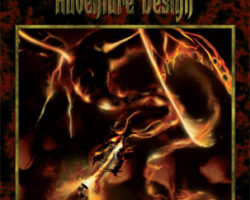Tome of Adventure Design by Matthew J. Finch and published by Frog God Games is a role playing game supplement for creating adventures. It is a resource for GameMasters to create adventures by providing advice and inspiration.
The supplement is available from RPGNow as a PDF for $21 although it was purchased at the reduced price of $8.40. It may be possible to pick up printed copies of the book as well. This is a 308 page bookmarked PDF. Two pages are the colour front and back covers, one page is the front matter, one page the Table of Contents, one page the Introduction and Creativity and six pages are the Complete List of Tables and Consolidated Index.
 The PDF is divided into four books, which may have been published separately at one point. Each book is primarily a collection of tables, all d100 in nature although the number of results varies from a handful up to 100.
The PDF is divided into four books, which may have been published separately at one point. Each book is primarily a collection of tables, all d100 in nature although the number of results varies from a handful up to 100.
Book One: Principles and Starting Points covers what is stated as being the topmost level of adventure design; creating the story, the mission, the locations and the plan of the villain.
Book Two: Monsters is on creating new monsters, which are divided into different types, such as beasts, elementals, constructs, giants etc. This covers appearance and abilities of such created monsters.
Book Three: Dungeon Design is on creating dungeons, which are considered to be two types, lairs, where a mission can easily be finished in a small location, and megadungeons, which can involve multiple game session. This considers building and dressing dungeons, including such as traps and riddles.
Book Four: Non-Dungeon Adventure Design covers creating adventures that are not in a dungeon location, which does have differences as players have more open options; in a dungeon, if movement isn’t possible in a particular direction, it isn’t possible. This covers locations such as aerial, castles and ruins, cities and settlements, different planes, underwater, waterborne and wilderness.
Tome of Adventure Design in Review
The PDF is very well bookmarked, with every table linked as well as the main sections. The Table of Contents is less thorough, with only the major sections and books listed. Each book has an index of every table at the end of it and the end of the book has a complete list of every table and a Consolidated Index. Navigation is therefore above average. The text maintains a two column format and no errors were noticed. There are a number of black and white illustrations but most of them, and perhaps all of them, have been reused from Rappan Athuk.
Although the book is stated as being for Swords & Wizardry and the Pathfinder Roleplaying Game, there are absolutely no game stats included, so it is actually suitable for the majority of fantasy role playing games, and much of it for other genres.
Most of the book is comprised of tables (reminiscent of The Classic Dungeon Design Guide or perhaps it’s the other way around, given that this was released first) and, by itself, the book will not create adventures. The would-be adventure creator will still need to add their own input or translate the basic ideas into game terms, otherwise, all that is accomplished is a bunch of randomly generated results with no real connection. Some prior knowledge on creating adventures is needed; this is not really a book of adventure design philosophy and principles. It is highly doubtful that many GMs would be able to create an entire adventure using just this book in the short length of time that is suggested on the back cover (under two hours). Simply rolling on the tables will take a significant amount of time and then the results will need assembling into something coherent. Some tables can be used on the fly but the majority will require a lot of input.
Having said that, this is a really, really well organised and put together set of tables. Each table has many different results, many tables are comprised of multiple sections that each need rolling on and the various pieces of text explain some of the tables and the principles behind how they are being used. The tables are not just useful for creating adventures (for which they serve more as a source of inspiration) but also for dressing areas on the fly and adding new content. Creating monsters will require quite a lot of work from the random results; the amount of work will depend on the system – Pathfinder monsters will require more input than those for Swords & Wizardry.
One benefit of the book is that the tables were created for the author’s own use, and have been used for such, so they are tried and tested and over a fair amount of time. They probably are more intended for Old School systems than newer ones, but the difference is mostly in the level of complexity needed to translate the results into something suitable for some more modern systems.
As a source of inspiration the book is excellent. Simply reading through the tables can spark ideas for use, and that’s without even using them in the way they are intended, by random rolling (although the random rolling is also intended to spark creativity). If a GM is looking for principles on creating adventures and assembling them together, then this probably isn’t the book for them (How to Write Adventure Modules That Don’t Suck and similar books of advice are probably more suited to that type of creation). If they are looking for incredibly detailed levels of random generation with millions of different ideas, then Tome of Adventure Design is what they are looking for and it can be found by clicking here.

Leave a Reply